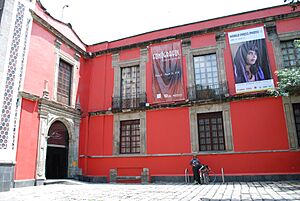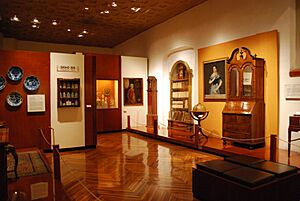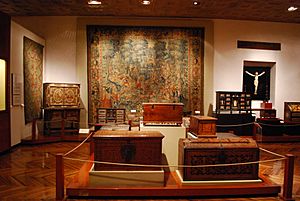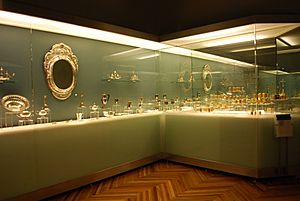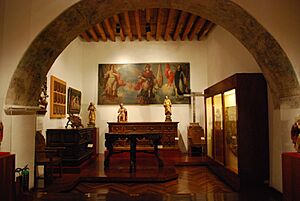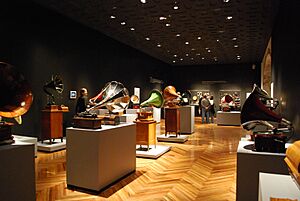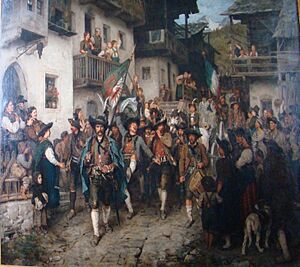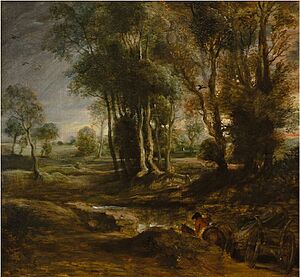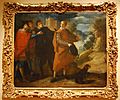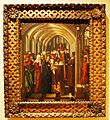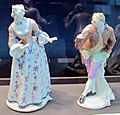Franz Mayer Museum facts for kids
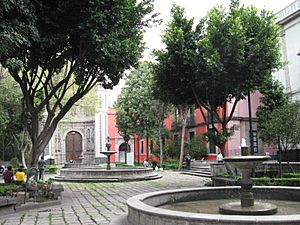
Courtyard of the Franz Mayer Museum (on right) and one of the entrances of the Parish of La Santa Vera Cruz de San Juan de Dios Church.
|
|
| Established | 1986 |
|---|---|
| Location | Av Hidalgo 45. Centro Histórico 06300, Mexico City, Mwxico |
The Franz Mayer Museum (Spanish: Museo Franz Mayer) is a special place in Mexico City. It opened in 1986 to show off a huge collection of decorative arts. This collection is the biggest of its kind in Latin America!
A man named Franz Mayer spent over fifty years gathering these amazing items. He was a stockbroker, but his real passion was collecting beautiful things. His collection includes artworks, old books, furniture, pottery, textiles, and many other decorative pieces. While some items are from Europe and Asia, most come from Mexico and date from the 15th to the 20th centuries. Many are fine handcrafts, like Talavera pottery. These pieces are important because they show us everyday items that people often didn't save, but Franz Mayer knew they were treasures!
The museum is located in a very old building in the heart of Mexico City. It used to be a monastery and hospital in the 1700s. Today, the museum not only displays Mayer's collection but also adds new pieces. It offers fun workshops, hosts temporary exhibits, and even has a cozy café in its beautiful garden courtyard.
Contents
Discover the Franz Mayer Museum
The Franz Mayer Museum was created to share the incredible collection of art and objects gathered by Franz Mayer. He spent more than 50 years collecting these items during his lifetime. Before he passed away in 1975, Franz Mayer set up a special fund with the Bank of Mexico. This fund was called the Franz Mayer Cultural Trusteeship.
However, the museum didn't open its doors until 1986, eleven years after Mayer's death. It found its home in an old monastery and hospital building. This historic building was given to the museum foundation.
The museum's main exhibits still feature Mayer's original collection. But researchers at the museum are always looking for new and interesting pieces to add. For example, one of the newest items is a silver skull from Guatemala.
Only about a quarter of the museum's entire collection is on display at any time. The other pieces are often loaned to other museums around the world. The museum hopes to grow and open more locations in the future.
The museum helps us understand decorative arts from the past. It shows how these old designs influence art today. They even work with modern artists who create ceramics and silver items. This allows new designs to be displayed alongside the historical pieces.
You can enjoy many activities at the museum. They offer guided tours, interesting classes, lectures, and even concerts. There are also special workshops just for kids and fun events for museum members. Don't forget to visit the lovely café in the main courtyard, which has a beautiful garden!
The museum often hosts special exhibits. For its 25th anniversary in 2011, there was an exhibit called "Susurros" (Whispers). It told the story of how the museum's collection came to be.
The Museum's Historic Home
The museum building is located in the Plaza de la Santa Veracruz. It's right next to the Museo Nacional de la Estampa. This building has a long and fascinating history! It was first built as a flour mill. Then, for about 400 years, it served as a hospital.
Dr. Pedro Lopez founded this hospital in 1582. He was the first doctor to graduate from the Royal and Pontifical University of Mexico. The hospital cared for people from all walks of life in New Spain. It was known as the Hospital for the Helpless.
Different groups ran the hospital over the centuries. The Brothers Hospitallers of St. John of God took over in 1604. The building we see today was mostly built during the 1700s. It was rebuilt several times due to events like a fire in 1766 and an earthquake in 1800.
After Mexico became independent in 1821, the Brothers had to leave. The building then became a school for a while. Later, it was a hospital again, known as Morelos Hospital. It continued as a hospital until the 1960s.
In the 1960s, the building was used to display handcrafts during the Olympic Games. It kept this role through the 1970s, but it started to fall apart.
In the 1980s, people had the idea to turn it into a museum. The government gave the building to the Franz Mayer Cultural Trusteeship. This group, managed by the Bank of Mexico, planned to create the museum. The building was carefully restored during this time. Finally, the Franz Mayer Museum opened to the public in 1986. Today, the museum uses parts of the old hospital, including a dining hall, a storage room, and a chapel. These rooms have been restored to look like they did long ago.
Amazing Art Collections
The museum's collection mostly comes from Franz Mayer himself. He gathered these items over fifty years. It is the largest collection of decorative arts in Latin America! The museum has about 9,500 art pieces, 1,400 ceramic items, and 10,000 books. Only about 28% of these can be shown at one time.
The collection includes beautiful silverwork, ceramics, furniture, and textiles. You'll also find fine arts and decorations made from feathers, lacquer, ivory, shells, glass, and enamel. Most pieces are from the 16th to the 19th centuries. They come from many different places and show various styles.
Many items were used in everyday life but were made with great skill. While some pieces are from Europe and Asia, Mayer collected a huge number from Mexico City, Puebla, and Guanajuato. The textile collection is very important because it has about 260 pieces from the 15th to the 20th centuries. Many of these everyday items might have disappeared if Mayer hadn't saved them.
The furniture collection is one of the best in Mexico. It has 710 pieces from the 16th to the 20th centuries. Most are from Mexico's colonial period, but there are also pieces from Europe and Asia.
The silver collection has almost 1,300 pieces from the 15th to 19th centuries. It's known as one of Mexico's most important collections. You can see pieces with detailed designs like repoussé work and filigree. Some even have precious stones or enamel. Many silver items were used in Catholic churches, like censers, chalices, and crosses. But there are also non-religious items, such as cigarette cases, cutlery, and trays.
The textile collection is very diverse. It's one of the few collections in Mexico with so many different samples. Mayer started by collecting rebozos (Mexican shawls) and blankets from Saltillo. He also collected Flemish tapestries, shawls from Manila, dresses, and church garments. Mexican textiles include those made on traditional looms from the colonial period. Some pieces feature amazing embroidery with gold and silver thread. Many rugs are from Europe and Spain but have designs inspired by the East.
The museum is one of the few places where you can see European and Mexican paintings together. European paintings date back to the 14th century. Spanish works include those by famous artists like José de Ribera and Francisco de Zurbarán. Italian art is represented by Lorenzo Lotto. Northern European painters like Jacob Grimmer are also featured.
Mexican works are mostly from the colonial period. They include paintings by Juan Correa and Miguel Cabrera. Most of these paintings are religious, but there are a few portraits from the 1700s. Later Mexican works include a landscape by José María Velasco and an early painting by Diego Rivera.
In the 1920s, Mayer started collecting Talavera pottery from Puebla. He was one of the first people to do this! Locals in Puebla thought he was a bit strange for buying all their "old stuff." When the museum opened, it had the largest collection of Puebla Talavera in the world. It includes 726 pieces from the 17th to the 19th centuries, plus some 20th-century works.
An important part of the museum is the Rogerio Casas-Alatriste H. Library. It's named after the museum's first director. This library holds Mayer's amazing book collection. He bought many books to learn more about the art pieces he owned or wanted to buy. The library is in the cloister area and has over 14,000 books. This includes 800 different editions of Don Quixote and a very old book called the Chronicles of Nuremberg, printed in 1493. The library has a classic design with shelves made of cedar to protect the books. The wooden floor and some decorations in the library came from Mayer's original house.
In 2004, an anthropologist named Ruth D. Lechuga gave her private collection to the museum. This collection has over 14,000 artifacts, 5,000 books, and 1,000 personal items. They tell the story of Lechuga's life, from her family escaping the Nazi Anschluss in Austria to her research on Mexico's native peoples. In 2016, the Ruth D. Lechuga Center for Popular Art Studies opened in the museum's basement.
Who Was Franz Mayer?
Franz Mayer-Traumann Altschu was born in Germany in 1882. He came to Mexico in 1905. He left for a short time during the Mexican Revolution but returned for good in 1913. That year, he married María Antonieta de la Macorra, but she sadly passed away soon after. Mayer never remarried and didn't have any children.
Mayer became a very successful businessman, mainly working in stocks and finance. He became a Mexican citizen in 1933.
Franz Mayer had many hobbies, including photography and traveling around Mexico and other countries. He admired the photographer Hugo Brehme and collected some of his pictures. Mayer also took his own photos, and these are now part of the museum's collection.
However, he is most famous for his incredible collection of decorative arts. These items filled his house in the Lomas de Chapultepec neighborhood. He started collecting textiles as early as 1905. He often bought Mexican textiles to send as gifts to his family and friends in Europe. As a collector, Mayer gathered more than 10,000 artworks and a similar number of books. He began buying fine art at auctions in 1933. The museum still has many of the auction catalogs he used. The museum also keeps letters Mayer wrote to experts, asking about pieces he owned or was interested in. After art, he started collecting books, including many editions of Don Quixote. He began collecting Talavera ceramics and tiles in 1943. Mayer also had a collection of beautiful orchids, cactus, and azaleas, which his gardener, Felipe Juárez, cared for.
In 1963, Mayer decided to create a special fund. His goal was to donate his entire collection to a museum dedicated to it. The Bank of Mexico was chosen to manage this fund. The donation was finalized when Mayer passed away in 1975. The museum to house his amazing collection opened its doors in 1986.
Images for kids
See also
 In Spanish: Museo Franz Mayer para niños
In Spanish: Museo Franz Mayer para niños
- Casa de Madera Museum, Tenango del Aire
- Museo Objeto del Objeto


